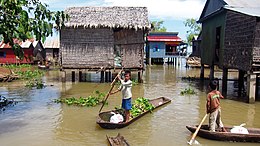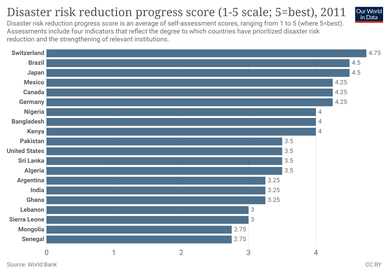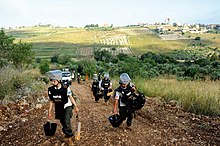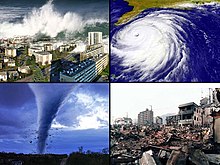
Disaster risk reduction

Disaster risk reduction (DRR) sometimes called disaster risk management (DRM) is a systematic approach to identifying, assessing and reducing the risks of disaster. It aims to reduce socio-economic vulnerabilities to disaster as well as dealing with the environmental and other hazards that trigger them. The most commonly cited definition of Disaster risk reduction is one used by UN agencies such as United Nations Office for Disaster Risk Reduction (UNDRR) and the United Nations Development Programme (UNDP): "DRR is aimed at preventing new and reducing existing disaster risk and managing residual risk, all of which contribute to strengthening resilience and therefore to the achievement of sustainable development".
Disaster risk reduction has been strongly influenced by the research on vulnerability since the mid-1970s as well as the mapping of natural disaster risks. Disaster risk reduction is the responsibility of development and relief agencies alike. It should be an integral part of the way such organizations do their work, not an add-on or one-off action. Disaster risk reduction is very wide-ranging: Its scope is much broader and deeper than conventional emergency management. There is potential for disaster risk reduction initiatives in most sectors of development and humanitarian work.
Definition
Disaster risk reduction (DRR) is defined by United Nations Office for Disaster Risk Reduction (UNDRR) as actions "aimed at preventing new and reducing existing disaster risk and managing residual risk, all of which contribute to strengthening resilience and therefore to the achievement of sustainable development".
Development of the concept and approach
From disaster management
Disaster management thinking and practice since the 1970s has included more focus on understanding why disasters happen. It has also focused on actions that can reduce risk before a disaster occurs. This has put more emphasis on mitigation and preparedness in addition to the response and recovery phases of disasters. It has been widely embraced by governments, disaster planners and civil society organisations.
DRR is such an all-embracing concept that it has proved difficult to define or explain in detail, although the broad idea is clear enough. It is generally understood to mean the broad development and application of policies, strategies and practices to minimise vulnerabilities and disaster risks throughout society. Its policy goals and objectives are defined in disaster risk reduction strategies and plans.
The term 'disaster risk management' (DRM) is often used in the same context and to mean much the same thing. That is, a systematic approach to identifying, assessing and reducing risks of all kinds associated with hazards and human activities. DRM is more properly applied to the operational aspects of DRR: the practical implementation of DRR initiatives. In other words, disaster risk reduction is the policy objective of disaster risk management.
Climate change adaptation
Climate change, through rising temperatures, changing rainfall patterns, and changing sea levels, affects the nature of hydro meteorological hazards that can give rise to a disaster. Examples of such hazards are droughts, floods, and cyclones.
Because climate change is one contributor to disaster risk, climate change adaptation is sometimes seen as one of many processes within disaster risk reduction. In turn, disaster risk reduction should sit within sustainable development to avoid isolation from topics wider than disaster risk.
Disasters are often triggered by natural hazards but are always linked to human action (or inaction) or rooted in anthropogenic processes. Disasters, economic loss and the underlying vulnerabilities that drive risk are increasing, and global risks like climate change are having major impacts in every locality. As climate change is projected to increase the frequency and severity of extreme weather events and disasters, adaptation may also include measures towards increased preparedness and relevant disaster response capacities.There are growing efforts to closely link DRR and climate change adaptation, both in policy and practice. This linkage has clearly revealed the significance of disaster risk reduction for sustainable development planning. An underlying process refers to the ability of disaster risk management to alter existing development trajectories as transformation, which “involve[s] fundamental changes in the attributes of a system, including value systems; regulatory, legislative, or bureaucratic regimes; financial institutions; and technological or biophysical systems”. Transformation occurs as society learns. This learning includes building partnerships, which helps to increase local capacity and contribute to institutional change. This in turn allows society to continually move from vulnerability, adaptation and development to resilience.
There has been an increase in the economic losses from weather- and climate-related disasters, which contributed to $165 billion of economic losses worldwide in 2018 according to estimates from insurance giant Swiss Re.
Resilience
In disaster risk reduction, the concept of resilience expresses one goal of disaster prevention and response. Resilience refers to the ability of a community or society to preserve its essential structure and function in the face of stress and shocks. Resilience is closely connected to the concept of vulnerability, though resilience tends to be a higher, strategic goal of building social systems, while vulnerability is a tool for analyzing the properties of those systems.
The term resilience issues from the ecological sciences as a description of a system’s response to change, originally coming from the Latin resilire, “to bounce [back]”. It was first used in the present sense by C.S. Holling in 1973, as a measure of the ability of relationships within a natural system to persist, i.e., for the organisms within the system to not go extinct. Resilience in the ecological sense is not equilibrium: it differs from stability, the ability of a system to resist fluctuation. A system that is resilient, therefore, can undergo changes without losing its core structure and function. In the case of human systems, that function is survival and the necessities of life.
Within the field of disaster risk reduction, one widely-accepted definition of resilience comes from UNISDR: “The ability of a system, community or society exposed to hazards to resist, absorb, accommodate to and recover from the effects of a hazard in a timely and efficient manner, including through the preservation and restoration of its essential basic structures and functions.”
The importance of resilience in disaster risk management can be seen from the centrality of the term in the 2005-2015 Hyogo Framework for Action, which was subtitled “Building the Resilience of Nations and Communities to Disasters.” Building resilience, therefore, is currently understood as the goal of disaster risk reduction.
Policy arena
There have been growing calls for greater clarity about the components of DRR and about indicators of progress toward resilience — a challenge that the international community took up at the UN's World Conference on Disaster Reduction (WCDR) in Kobe, Japan, in 2005, only days after the 2004 Indian Ocean earthquake. The WCDR began the process of pushing international agencies and national governments beyond the vague rhetoric of most policy statements and toward setting clear targets and commitments for DRR.
Hyogo Framework for Action
The first step in this process was the formal approval at the WCDR of the Hyogo Framework for Action (2005–2015) (HFA). This was the first internationally accepted framework for DRR. It set out an ordered sequence of objectives (outcome – strategic goals – priorities), with five priorities for action attempting to 'capture' the main areas of DRR intervention. The UN's biennial Global Platform for Disaster Risk Reduction provided an opportunity for the UN and its member states to review progress against the Hyogo Framework. It held its first session 5–7 June 2007 in Geneva, Switzerland, where UNISDR is based. The subsequent Global Platforms were held in June 2009, May 2011 and May 2013, all in Geneva.
Sendai Framework for Disaster Risk Reduction
Other international initiatives
UN initiatives have helped to refine and promote the concept at international level, stimulated initially by the UN's designation of the 1990s as the International Decade for Natural Disaster Reduction. In 1999, UN member states approved the International Strategy for Disaster Risk Reduction, which reflected a shift from the traditional emphasis on disaster response to disaster reduction, by seeking to promote a "culture of prevention". In a further step to promote a global culture of disaster risk reduction the UN General Assembly designated an international day, which is now known as the International Day for Disaster Risk Reduction on October 13th.
Disaster risk is an indicator of poor development, so reducing disaster risk requires integrating DRR practice into the 17 Sustainable Development Goals. Decision makers need to manage risks, not just disasters.
National planning
As of 2022, the number of countries with national strategies for DRR was 125. This is a large improvement since the adoption of the Sendai Framework (from 55 in 2015).
Bangladesh
Based on the Climate Risk Index, Bangladesh is one of the most disaster-prone countries in the world. Bangladesh is highly vulnerable to different types of disasters because of climatic variability, extreme events, high population density, high incidence of poverty and social inequity, poor institutional capacity, inadequate financial resources, and poor infrastructure. Bangladesh commenced its disaster preparedness following the cyclone of 1991 and has now a comprehensive National Plan for Disaster Management which provides mechanisms at both national and sub-national levels.
European Union
In addition to providing funding to humanitarian aid, the European Commission's Directorate-General for European Civil Protection and Humanitarian Aid Operations (DG-ECHO) is in charge of the EU Civil Protection Mechanism to coordinate the response to disasters in Europe and beyond and contributes to at least 75% of the transport and/or operational costs of deployments. Established in 2001, the Mechanism fosters cooperation among national civil protection authorities across Europe. Currently 34 countries are members of the Mechanism; all 27 EU Member States in addition to Iceland, Norway, Serbia, North Macedonia, Montenegro, Turkey and Bosnia and Herzegovina. The Mechanism was set up to enable coordinated assistance from the participating states to victims of natural and man-made disasters in Europe and elsewhere.
Cost and financing
Economic costs of disasters are on the rise, but most humanitarian investment is currently spent on responding to disasters, rather than managing their future risks. Only 4% of the estimated $10 billion in annual humanitarian assistance is devoted to prevention (source), and yet every dollar spent on risk reduction saves between $5 and $10 in economic losses from disasters. A case study of Niger showed positive cost and benefit results for preparedness spending across 3 different scenarios (from the absolute level of disaster loss, to the potential reduction in disaster loss and the discount rate), estimating that every $1 spent results in $3.25 to $5.31 of benefit.
Issues and challenges
Communities and their organizations
Traditional emergency management/civil defense thinking makes two misleading assumptions about communities. First, it sees other forms of social organisation (voluntary and community-based organisations, informal social groupings and families) as irrelevant to emergency action. Spontaneous actions by affected communities or groups (e.g., search and rescue) are viewed as irrelevant or disruptive, because they are not controlled by the authorities. The second assumption is that disasters produce passive 'victims' who are overwhelmed by crisis or dysfunctional behavior (panic, looting, self-seeking activities). They therefore, need to be told what to do and their behavior must be controlled — in extreme cases, through the imposition of martial law. There is plenty of sociological research to refute such 'myths'.
An alternative viewpoint, informed by a considerable volume of research, emphasises the importance of communities and local organisations in disaster risk management. The rationale for community-based disaster risk management that it responds to local problems and needs, capitalises on local knowledge and expertise, is cost-effective, improves the likelihood of sustainability through genuine 'ownership' of projects, strengthens community technical and organisational capacities, and empowers people by enabling them to tackle these and other challenges. Local people and organisations are the main actors in risk reduction and disaster response in any case. Consequently, it has been seen that understanding the social capital already existent in the community can greatly help reducing the risk at the community level.
Governance
In most countries, risk management is decentralized to local governments. In urban areas, the most widely used tool is the local development plan (municipal, comprehensive or general plan), followed by emergency and risk reduction plans that local governments are required to adopt by law and are updated every 4–5 years. Larger cities prefer stand-alone plans, called, depending on the context, sustainable, mitigation, or green plans. In rural areas, the mainstreaming of risk reduction policies into municipal (county or district) development plans prevails. In many contexts, especially South of the Sahara, this process clashes with the lack of funds or mechanisms for transferring resources from the central to the local budget. Too often plans do not integrate local, scientific and technical knowledge. Finally, they entrust the implementation of policies to individual inhabitants without having fully involved them in the decision-making process. The authentic representativeness of the communities and gender participation in the decision-making process still remain an objective of the local development plans instead of being the way to build them.
Gender
Disaster risk is not gender-neutral. Studies have shown that women and girls are disproportionately impacted by disasters. Following the 2004 tsunami in the Indian Ocean, 77% and 72% of the deaths in the districts of North Aceh and Aceh Besar, Indonesia, were female. And in India 62% of people who died were female. This is due to socially-constructed gender roles that determine what norms and behaviors are acceptable for women and men, and girls and boys. In particular, women tend to take responsibility for home-based tasks and can be reluctant to leave their assets in the case of hazard warning; and often do not learn survival skills that can help in disasters, such as learning to swim or climb.
A gender-sensitive approach would identify how disasters affect men, women, boys and girls differently and shape policy that addresses people's specific vulnerabilities, concerns and needs.
See also
External links
- Ecosystem-based Disaster Risk Reduction
- Disaster Risk Management Society, GC University, Lahore.
- Asian Disaster Preparedness Center
- FAO – Platform for East and Central Africa
- EM-DAT: The International Disaster Database
- Global Facility for Disaster Reduction and Recovery
- United Nations Office for Disaster Risk Reduction
- Preventionweb – Building the resilience of nations and communities to disasters
- The World Bank, Hazards Management Unit
- United Nations Platform for Space-based Information for Disaster Management and Emergency Response
| Overview | |||||||||||||||||||||||||||||||||||||||||||||
|---|---|---|---|---|---|---|---|---|---|---|---|---|---|---|---|---|---|---|---|---|---|---|---|---|---|---|---|---|---|---|---|---|---|---|---|---|---|---|---|---|---|---|---|---|---|
| Disasters |
|
||||||||||||||||||||||||||||||||||||||||||||
| Preparation | |||||||||||||||||||||||||||||||||||||||||||||
| Countermeasures | |||||||||||||||||||||||||||||||||||||||||||||
| Media | |||||||||||||||||||||||||||||||||||||||||||||
| Organizations | |||||||||||||||||||||||||||||||||||||||||||||
| Authority control: National |
|---|



